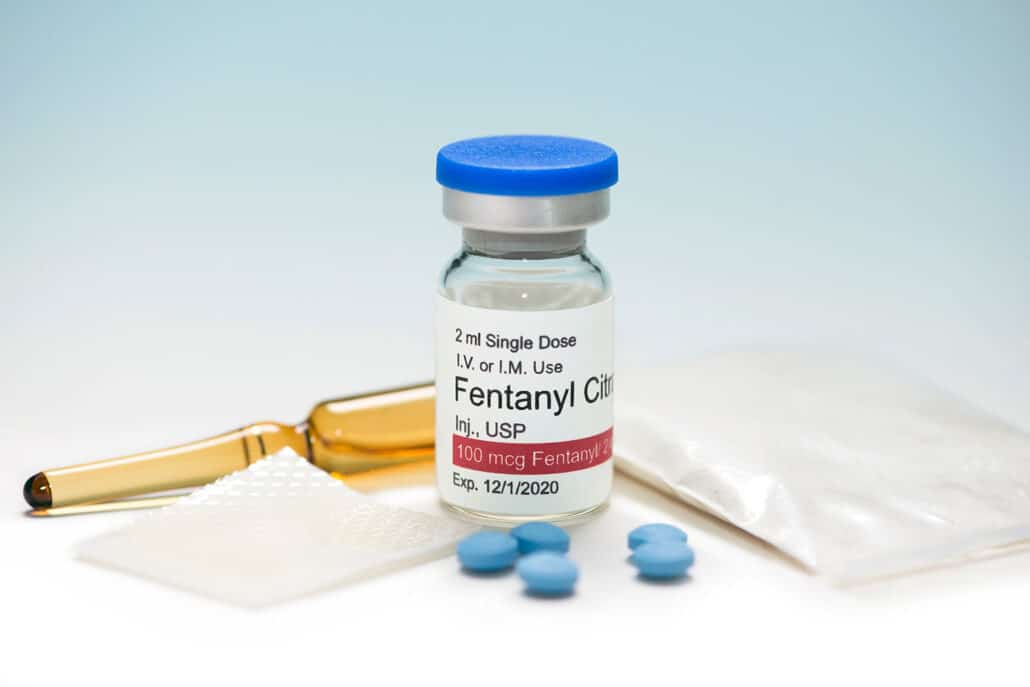Fentanyl is a powerful opioid. It’s up to 100 times stronger than morphine and is only prescribed in the most serious of severe pain cases. Dealers like it because it’s cheaper to make than heroin, easier to carry because it comes in sealed patches, and the demand for it is high after the crackdown on other opioids. During the pandemic, fentanyl use skyrocketed, leading to many of the hundreds of thousands of drug-related deaths, including overdose deaths from 2020 to 2022. Some of those deaths came from folks trying to quit and/or detox from the drug improperly. The process is not pleasant and must be overseen by physicians and other well-trained personnel to be truly safe and effective.

Table of Contents
The Withdrawal Symptoms
As with any potent drug, stopping its use causes withdrawal. Some of the symptoms, such as diarrhea or vomiting, are unpleasantly annoying but not life-threatening. Others, such as tachycardia and high blood pressure, can be, especially if the person attempts to stop fentanyl cold turkey. The dehydration that comes along with diarrhea and vomiting can be problematic, too, which can exacerbate other symptoms of withdrawal and make the person susceptible to complications. Worst of all, if a person attempts to detox from fentanyl without supervision, the temptation to start again can be catastrophic because the person will have a reduced tolerance after having stopped for a period of time, no matter how short.
How bad the withdrawal is depends on the length of time that the person has been taking fentanyl, how much the person took, and how often the person took the drug over that time. The drug is a short-acting opioid. Because of that, the symptoms of withdrawal usually appear between eight and 24 hours after the person’s last dose. Withdrawal can last a few days up to weeks. Fentanyl is physically addicting as well as psychologically addicting. The person builds up a tolerance and then needs more and more of the drug to achieve the desired effect. In extreme cases, quitting cold turkey will be lethal, although this is rare. Extremely high doses of fentanyl can also be lethal, so it’s crucial to help addicted folks as quickly and safely as possible before it reaches a point that the person has to take so much to achieve the euphoric effect that the person dies.
The Detoxification
There are generally three phases to detoxing from any drug, and fentanyl is no exception. The best method for detox is to have it be medically supervised so that medical professionals are on hand to handle any serious complications. The stages are early, peak, and long-term.
Early Stage
About two to four hours after a person’s last dose, that person will begin to suffer anxiety about not having the drug. Muscle pain and involuntary contractions begin, and the person might also experience chills and profuse sweating. The cravings begin, and they can become so potent as to make sleep impossible. The person’s nose will run, often uncontrollably, which also contributes to insomnia, and the person could “get the shakes” as well. These symptoms can be scary, but they usually aren’t dangerous at this stage. Still, staying in treatment through the entire detox process is essential because leaving at this stage will usually lead to relapse.

Peak Stage
The early stage progresses to the peak stage about two days after the person’s last dose. The symptoms will be the same as in the early stage, but they will be much more severe. The “shakes” will turn into seizures and possibly life-threatening convulsions, and the psychological damage from the cravings will be crushing. The person will need constant medical supervision that includes mental-health support as well as support for the physical symptoms. Depression is common, and so are intense mood swings. Society shames addicts, and that leads to self-loathing and a tendency to make up excuses about why to start using again. “I might as well start using again because I’m a filthy drug user,” or similar is a common refrain, which is why psychological support is crucial to the person’s success at treating the addiction. Society’s opinion isn’t relevant when it comes to healing from being an addict.
Long-Term Stage
About seven to 10 days after beginning detox, the nightmarish peak stage will subside. The long-term effects of fentanyl use, however, can also be intensely unpleasant. For example, the person might suffer from anhedonia, which is an inability to experience pleasure, because the fentanyl has deadened the nerves of the pleasure center. When that happens, it’s possible that both the depression and the self-loathing can increase in strength, necessitating stronger treatment for longer periods of time. In rare cases, the effects can be lifelong.
Relapse dreams and the anger and guilt associated with them are also powerful long-term effects of fentanyl use. The frustration from those two things, along with the constant cravings that are still present, can lead to actual relapse. The only fortunate thing is that the cravings aren’t nearly as strong as they were in previous stages.
To mitigate the severity of the withdrawal and possibly to control the long-term effects, doctors sometimes prescribe either methadone or buprenorphine. Both of these drugs are opioid agonists. That means that they interfere with the action of the drug upon the nerves. One must be careful with these drugs, too, because they can both cause addiction if not taken correctly.
The Pink Cloud
The Pink Cloud is an evil effect that some people experience both while detoxing and shortly thereafter. It is a feeling of euphoria at “having beaten the drug.” People feel positive and hopeful. They can be calm. They’ll make commitments to change their lives. The evilness comes from the fact that these benefits often come with an inability to grasp the seriousness of the situation and the true lifelong commitments that are necessary to stay sober. The tragedy is that the good feelings, often as not, lead to relapse and failure because of the false sense of security that they engender in the person.

The Role of Therapy
Because fentanyl has the possibility of creating a lifelong dependence and a struggle against the cravings to use, supportive mental health care is a necessary part of dealing with all of it. The people in that situation must learn new coping skills and make wholesale changes in their lives, which include possibly withdrawing from family members and friends who acted as enablers and planning for a completely different future. The people have to maintain their dedication to sobriety while returning to work, associating with remaining family members and friends after removing the enablers, and picking up the responsibilities that they left behind while they were using.
Remember, no matter how long it lasts, the Pink Cloud is not a sustainable state of mind. Reality will tear down the euphoric walls, and the person will have to prepare for that. As part of the therapy, too, the person should practice self-care. Don’t make too many goals for recovery too fast. Make them manageable, and be sure to allow time for leisure. Take up a new hobby, for example. The person could even take a day off occasionally and be a couch potato. Reconnecting with and making amends to family members and friends to rebuild a support network for the future is also a fine idea.
Where to Get Started
It can be difficult to know where to turn. Long Island Interventions, a treatment center, however, doesn’t provide actual rehabilitation or detox treatment options for substance abuse or substance use disorder, opioid overdose, opioid use disorder, or any other drug addiction treatment, but the organization partners with many facilities that do. Long Island Interventions, as a treatment facility and recovery center, is ready to put you in touch with the right help when it comes to your substance abuse treatment plan and support you for your drug abuse rehab program as you begin your journey or loved one and enhance well-being. Call today, or come by the office to find out more about the rehab center, drug use or opioid drug side effects, and other opioid addictions.
FAQ
How does a fentanyl addiction treatment program incorporate various treatment options?

